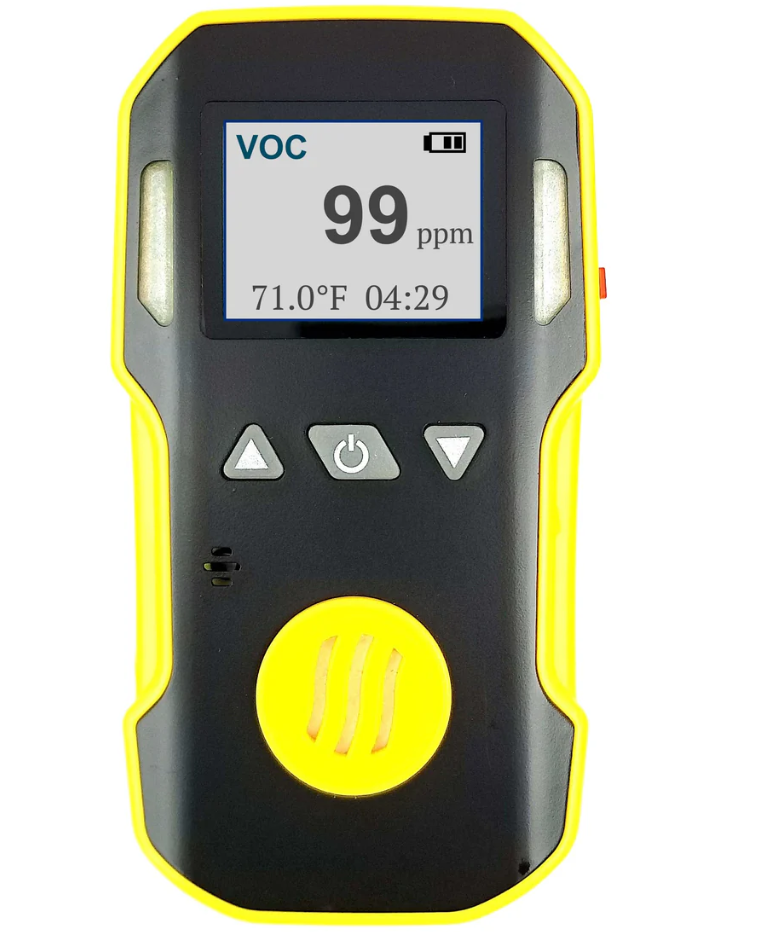Methyl Ethyl Ketone (MEK) gas detection is crucial in industrial environments where this volatile organic compound is used as a solvent, paint thinner, and cleaning agent. MEK gas and vapor detectors serve as primary safety instruments by monitoring concentration levels and providing early warning of potentially hazardous conditions. These sophisticated monitoring devices are particularly vital in manufacturing facilities, paint shops, and chemical processing plants where MEK is commonly handled. Regular detection and measurement of MEK vapors help prevent workplace exposure and ensure compliance with occupational safety standards. By incorporating advanced MEK detection systems, facilities can effectively monitor real-time vapor levels, trigger automated alerts, and maintain comprehensive safety protocols.
Pros |
Cons |
|
✅ Accuracy: Provides precise real-time monitoring of MEK vapor concentrations. ✅ Versatility: Suitable for both fixed and portable applications in various industrial settings. ✅ Safety Compliance: Helps maintain workplace safety standards and regulatory requirements. ✅ Durability: Built for long-term industrial use with proper maintenance. |
⛔ Maintenance: Requires regular calibration and sensor replacement. ⛔ High Cost: High initial cost for quality detection equipment. ⛔ Training: Demands skilled personnel for proper operation and maintenance. ⛔ Power Dependencies: Battery limitations in portable units and power supply requirements. |
What is the Best MEK Detector?
The Forensics Detectors VOC Gas Detector offers professional-grade detection with a 0-100 ppm range and 1 ppm resolution. Factory-calibrated in Los Angeles, this VOC detector features an advanced electrochemical sensor Its robust design includes shockproof and water-resistant construction, while comprehensive alarms (audio, visual, vibration) and 24-hour battery life ensure reliable workplace monitoring.
- VOC Gas Detector | USA NIST Calibration
- P-4635 Methyl Ethyl Ketone(MEK) Gas Detector
- Portable Methyl Ethyl Ketone C4H8O Gas Detector Handheld Detection Sensor
- Methyl Ethyl Ketone Gas Detector - Explosion Proof Version S2157MK
Is MEK a VOC?
Methyl Ethyl Ketone (MEK) is classified as a Volatile Organic Compound (VOC). It meets the key characteristics of VOCs, including high vapor pressure at room temperature and low water solubility. As an industrial solvent and chemical intermediate, MEK readily evaporates into the atmosphere, making proper detection and monitoring essential for workplace safety compliance.
What is a MEK Detector?
A MEK (Methyl Ethyl Ketone) detector is a specialized monitoring device that measures MEK vapor concentrations in industrial environments. It uses electrochemical sensor technology to provide real-time detection of MEK levels, typically measuring in parts per million (ppm). These detectors are essential safety instruments for protecting workers from harmful VOC exposure.
What is a MEK?
Methyl Ethyl Ketone (MEK), also known as 2-butanone, is a colorless industrial solvent with the chemical formula C4H8O. It's widely used in manufacturing processes for plastics, textiles, and coatings. As a volatile organic compound, MEK has a distinctive sweet odor and evaporates quickly at room temperature, requiring careful handling and monitoring.

Can MEK Vapor be Detected at PPM Levels?
Yes, MEK vapor can be detected at PPM (parts per million) levels using modern gas detection technology. Advanced electrochemical sensors and photoionization detectors (PIDs) can accurately measure MEK concentrations from 0-100 PPM with a resolution of 1 PPM. These precise measurements are essential for workplace safety compliance, as OSHA's permissible exposure limit for MEK is 200 PPM over an 8-hour time-weighted average. Reliable detection at PPM levels helps ensure worker protection and regulatory compliance.

What are MEK Exposure Limits?
Methyl Ethyl Ketone (MEK) exposure limits are as follows:
- OSHA: The Occupational Safety and Health Administration (OSHA) mandates a Permissible Exposure Limit of 200 parts per million over an eight-hour workday.
- NIOSH: The National Institute for Occupational Safety and Health (NIOSH) recommends 200 parts per million over an ten-hour workday and short-term max exposure of 300 ppm for 15-minute periods.
- ACGIH: Industrial hygiene experts at the American Conference of Governmental Industrial Hygienists (ACGIH) recommends 200 parts per million over an eight-hour workday and short-term max exposure of 300 ppm for 15-minute periods.
Why is MEK Detection Important in Workplaces?
MEK detection is crucial in workplaces as it serves multiple critical safety and compliance functions. In industrial environments where MEK is used as a solvent, detection systems provide real-time monitoring of vapor concentrations to prevent exposure beyond OSHA's permissible limit of 200 ppm over an 8-hour period. This monitoring not only protects workers from potential health risks like respiratory irritation and nervous system effects but also enables facilities to maintain regulatory compliance, identify equipment malfunctions early, and document their safety protocols effectively.
What are the Health Risks of MEK Exposure?
Exposure to Methyl Ethyl Ketone (MEK) presents significant health risks that vary based on concentration levels and duration of exposure. Short-term contact can cause immediate irritation to the eyes, nose, throat, and skin, often accompanied by headaches and dizziness. Extended exposure or higher concentrations may lead to more severe effects, including respiratory distress, nervous system complications, and potential liver and kidney damage. In extreme cases, prolonged inhalation of MEK vapors can result in unconsciousness. The compound can also be absorbed through skin contact, making proper protective equipment essential.

How Does MEK Compare to Other Industrial Solvents?
MEK stands out among industrial solvents due to its optimal balance of properties and performance characteristics. Compared to alternatives like acetone, toluene, and isopropyl alcohol, MEK offers superior solvency power for resins and coatings while maintaining a more favorable safety profile with its higher flash point.
Where Should MEK Detectors be Installed?
MEK detectors should be strategically installed in areas where these vapors are most likely to accumulate or where potential leaks could occur. Key installation points include production zones actively using MEK as a solvent, storage facilities, confined spaces, ventilation exhaust points, and transfer stations. Since MEK vapor is heavier than air, sensors should be positioned at both breathing zone level and lower areas, while considering air flow patterns and workplace traffic.
What Industries Require MEK Detection?
MEK detection is essential across diverse industrial sectors where this solvent plays a crucial role in manufacturing processes. Primary industries include paint and coating manufacturers, printing facilities, automotive manufacturing plants, electronics production facilities, and chemical processing plants. Additional sectors requiring MEK detection include aerospace manufacturing, furniture production facilities, adhesive manufacturers, and industrial cleaning operations where MEK serves as a primary solvent or cleaning agent. These industries must maintain strict monitoring protocols to ensure workplace safety and regulatory compliance.
What are the Different Types of MEK Sensors?
MEK detection primarily relies on three main sensor technologies: electrochemical sensors, photoionization detectors (PIDs), and metal oxide semiconductor (MOS) sensors. Electrochemical sensors offer high accuracy and specificity by measuring chemical reactions between MEK and electrode surfaces, while PIDs utilize ultraviolet light to ionize MEK molecules for detection, providing rapid response times and broad measurement ranges. MOS sensors, though less specific, offer cost-effective continuous monitoring by measuring conductivity changes when MEK vapors interact with the semiconductor surface. Each technology presents distinct advantages in terms of sensitivity, selectivity, response time, and cost-effectiveness, making sensor selection crucial for specific application requirements.
What is MEK also known as?
MEK stands for methyl ethyl ketone. Abbreviated as MEK. Other names also include Butanone or ethyl methyl ketone. Its chemical formula is C4H8O.
What is the Proper Response to MEK Alarms?
When an MEK alarm activates, immediate action is required following established safety protocols. Personnel should evacuate the affected area promptly while ensuring ventilation systems are operating properly. The incident response team must identify and isolate the source of MEK release while wearing appropriate personal protective equipment (PPE). Simultaneously, atmospheric readings should be monitored to determine vapor concentration levels and establish a safe perimeter. Only after the situation has been assessed by qualified personnel and MEK levels have returned to safe parameters should normal operations resume, followed by a thorough investigation to prevent future occurrences.
Some Facts About MEK Gas Detectors:
✅ MEK gas detectors are specialized instruments designed to measure and monitor concentrations of Methyl Ethyl Ketone vapor in industrial environments.
✅ MEK (2-butanone) is a volatile organic compound commonly used as an industrial solvent in manufacturing processes, particularly in coatings and adhesives.
✅ These detectors typically utilize electrochemical sensors or photoionization detectors (PIDs) for accurate measurement at PPM levels.
✅ Professional-grade MEK detectors offer features like real-time monitoring, multiple alarm systems, and data logging capabilities for workplace safety compliance.
✅ Detection equipment ranges from portable personal monitors to fixed installation systems, with various sensitivity ranges suitable for different industrial applications.
What Is The Characteristic Odor Of Methyl Ethyl Ketone (MEK) And At What Concentrations Is It Detectable?
Methyl Ethyl Ketone has a distinct sweet, acetone-like odor detectable at 5.4 ppm. Most people can smell it well below its permissible exposure limit of 200 ppm.
Final Word
The selection of a reliable MEK gas and vapor detector remains crucial for maintaining workplace safety and regulatory compliance. Professional-grade detection equipment, featuring accurate sensors and comprehensive alarm systems, provides the necessary safeguards against MEK exposure risks. Regular maintenance, proper calibration, and trained personnel ensure these detectors deliver optimal performance, making them an indispensable tool in industrial safety management.
About The Author
Dr. Kos Galatsis ("Dr.Koz") is the President of FORENSICS DETECTORS where the company operates from the scenic Palos Verdes Peninsula in Los Angeles, California. He is a subject matter expert on gas sensor technology, gas detectors, gas meters, and gas analyzers. He has been designing, building, manufacturing, and testing toxic gas detection systems for over 20 years.

Every day is a blessing for Dr. Koz. He loves to help customers solve their unique problems. Dr. Koz also loves spending time with his wife and his three children, going to the beach, grilling burgers, and enjoying the outdoors.
Read more about Forensics Detectors.
Email: drkoz@forensicsdetectors.com

